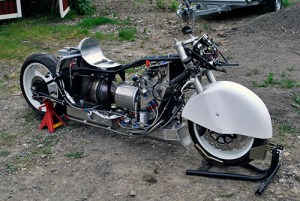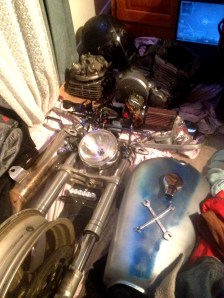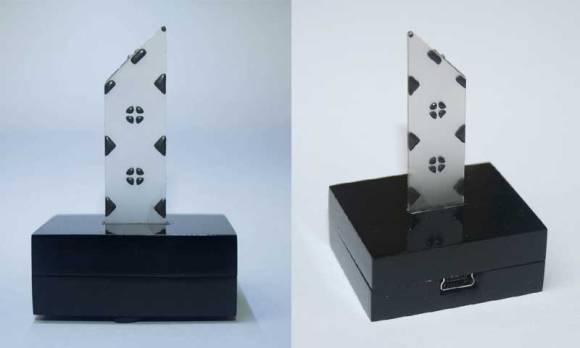
This week’s Hacklet focuses on two wheeled thunder! By that we mean some of the motorcycle and scooter projects on Hackaday.io.
 We’re going to ease into this Hacklet with [greg duck’s] Honda Sky Restoration. Greg is giving a neglected 15-year-old scooter some love, with hopes of bringing it back to its former glory. The scooter has a pair of stuck brakes, a hole rusted into its frame, a stuck clutch, and a deceased battery, among other issues. [Greg] already stripped the body panels off and got the rear brake freed up. There is still quite a bit of work to do, so we’re sure [Greg] will be burning the midnight 2 stroke oil to complete his scooter.
We’re going to ease into this Hacklet with [greg duck’s] Honda Sky Restoration. Greg is giving a neglected 15-year-old scooter some love, with hopes of bringing it back to its former glory. The scooter has a pair of stuck brakes, a hole rusted into its frame, a stuck clutch, and a deceased battery, among other issues. [Greg] already stripped the body panels off and got the rear brake freed up. There is still quite a bit of work to do, so we’re sure [Greg] will be burning the midnight 2 stroke oil to complete his scooter.
 Next up is [Anders Johansson’s] jaw dropping Gas turbine Land Racing Motorcycle. [Anders] built his own gas turbine engine, as well as a motorcycle to go around it. The engine is based upon a Garrett TV94, and directly powers the rear wheel through a turboshaft and gearbox. [Anders] has already taken the bike out for a spin, and he reports it “Pulled like a train” at only half throttle. His final destination is the Bonneville salt flats, where he hops to break the 349km/h class record. If it looks a bit familiar that’s because this one did have its own feature last month.
Next up is [Anders Johansson’s] jaw dropping Gas turbine Land Racing Motorcycle. [Anders] built his own gas turbine engine, as well as a motorcycle to go around it. The engine is based upon a Garrett TV94, and directly powers the rear wheel through a turboshaft and gearbox. [Anders] has already taken the bike out for a spin, and he reports it “Pulled like a train” at only half throttle. His final destination is the Bonneville salt flats, where he hops to break the 349km/h class record. If it looks a bit familiar that’s because this one did have its own feature last month.
 [GearheadRed] is taking a safer approach with FireCoates, a motorcycle jacket with built-in brake and turn signal indicators. [GearheadRed] realized that EL wire or LED strip wouldn’t stand up to the kind of flexing the jacket would take. He found his solution in flexible light pipes. Lit by an LED on each end, the light pipes glow bright enough to be seen at night. [GearheadRed] doesn’t like to be tied down, so he made his jacket wireless. A pair of bluetooth radios send serial data for turn and brake signals generated by an Arduino nano on [Red’s] bike. Nice work [Red]!
[GearheadRed] is taking a safer approach with FireCoates, a motorcycle jacket with built-in brake and turn signal indicators. [GearheadRed] realized that EL wire or LED strip wouldn’t stand up to the kind of flexing the jacket would take. He found his solution in flexible light pipes. Lit by an LED on each end, the light pipes glow bright enough to be seen at night. [GearheadRed] doesn’t like to be tied down, so he made his jacket wireless. A pair of bluetooth radios send serial data for turn and brake signals generated by an Arduino nano on [Red’s] bike. Nice work [Red]!
[Johnny ] rounds out this week’s Hacklet with his $1000 Future Tech Cafe Racer From Scratch. We’re not quite sure if [Johnny] is for real, but his project logs are entertaining enough that we’re going to give him the benefit of the doubt. Down to his last $1000, [Johnny] plans to turn his old Honda xr650 into a modern cafe racer. The new bike will have electric start, an obsolete Motorola Android phone as its dashboard, and a 700cc hi-comp Single cylinder engine at its heart. [Johnny] was last seen wandering the streets of his city looking for a welder, so if you see him, tell him we need an update on the bike!
] rounds out this week’s Hacklet with his $1000 Future Tech Cafe Racer From Scratch. We’re not quite sure if [Johnny] is for real, but his project logs are entertaining enough that we’re going to give him the benefit of the doubt. Down to his last $1000, [Johnny] plans to turn his old Honda xr650 into a modern cafe racer. The new bike will have electric start, an obsolete Motorola Android phone as its dashboard, and a 700cc hi-comp Single cylinder engine at its heart. [Johnny] was last seen wandering the streets of his city looking for a welder, so if you see him, tell him we need an update on the bike!
That’s it for this week. If you liked this installment check out the archives. We’ll see you next week on The Hacklet – bringing you the Best of Hackaday.io!














